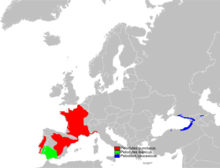
Bombinatoridae is a family of toads found in Eurasia. Species of the family have flattened bodies and some are highly toxic.
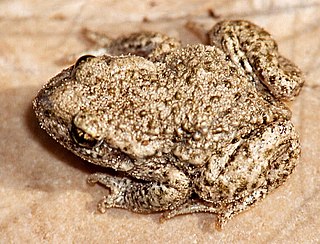
The Alytidae are a family of primitive frogs. Their common name is painted frogs or midwife toads. Most are endemic to Europe, but three species occur in northwest Africa, and a species formerly thought to be extinct is found in Israel.

Megophryidae, commonly known as goose frogs, is a large family of frogs native to the warm southeast of Asia, from the Himalayan foothills eastwards, south to Indonesia and the Greater Sunda Islands in Maritime Southeast Asia, and extending to the Philippines. Fossil remains are also known from North America. As of 2014 it encompasses 246 species of frogs divided between five genera. For lack of a better vernacular name, they are commonly called megophryids.

The Hyperoliidae, or sedge frogs and bush frogs, are a large family of small to medium-sized, brightly colored frogs which contain more than 250 species in 19 genera. Seventeen genera are native to sub-Saharan Africa. In addition, the monotypic genus Tachycnemis occurs on the Seychelles Islands, and the genus Heterixalus is endemic to Madagascar.

The vocal sac is the flexible membrane of skin possessed by most male frogs and toads. The purpose of the vocal sac is usually as an amplification of their mating or advertisement call. The presence or development of the vocal sac is one way of externally determining the sex of a frog or toad in many species; taking frogs as an example;

Sooglossidae, the Seychelles frogs or Seychelles Island frogs, are a family of frogs found on the Seychelles Islands. Until recently, this family was believed to include the genera Sechellophryne, Nesomantis and Sooglossus, but following a major revision of amphibians in 2006, the genus Nesomantis was named a junior synonym of Sooglossus. Their closest relatives are the purple frogs (Nasikabatrachidae) of India.
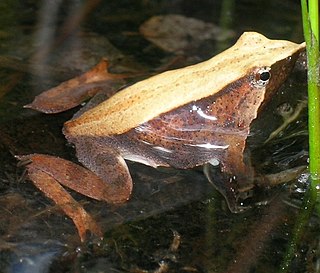
Rhinoderma, commonly known as Darwin's frogs, is a genus of small frogs found in Chile and adjacent parts of Argentina. It has just two species, of which the Chile Darwin's frog is highly endangered or may already be extinct. The better-known Darwin's frog is endangered.

The Microhylidae, commonly known as narrow-mouthed frogs, are a geographically widespread family of frogs. The 683 species are in 57 genera and 11 subfamilies.

The Rhacophoridae are a family of frogs in tropical sub-Saharan Africa, South India and Sri Lanka, Japan, northeastern India to eastern China and Taiwan, south through the Philippines and Greater Sundas, and Sulawesi. They are commonly known as shrub frogs, or more ambiguously as "moss frogs" or "bush frogs". Some Rhacophoridae are called "tree frogs". Among the most spectacular members of this family are numerous "flying frogs".

The European spadefoot toads are a family of frogs, the Pelobatidae, with only one extant genus Pelobates, containing six species. They are native to Europe, the Mediterranean, northwestern Africa, and western Asia.

The shovelnose frogs are the species of frogs in the genus, Hemisus, the only genus in the family Hemisotidae. They are found in tropical and subtropical sub-Saharan Africa. The shovelnose frogs are moderate-sized frogs, reaching a length of 8 cm (3.1 in). They are round-bodied, with short legs. Their heads are small and narrow, with hard, upturned noses.

Heleophrynidae is a family of frogs, commonly known as ghost frogs. They are thought to be the most basal group in the Neobatrachia. The family consists of two genera, Heleophryne and Hadromophryne, with seven species. Ghost frogs live in swift-moving mountain streams in South Africa. The common name of "ghost frogs" may have been coined because of their occurrence in Skeleton Gorge.

The Brachycephalidae are a family of frogs confined to eastern and southern Brazil and northern Argentina. The family is composed of two externally quite different genera: the tiny, often colourful and plump saddleback toads (Brachycephalus) from Brazil, and the larger, slimmer and more drab genus Ischnocnema from both Brazil and Argentina. The family is mainly defined by molecular characteristics, and are linked by few anatomical features. It was erected from two genera of the previously large family Eleutherodactylidae, which is now split into four families.

A true toad is any member of the family Bufonidae, in the order Anura. This is the only family of anurans in which all members are known as toads, although some may be called frogs. The bufonids now comprise more than 35 genera, Bufo being the best known.
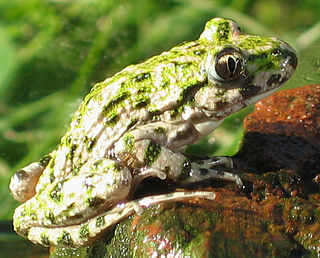
The common parsley frog is a species of frog in the genus Pelodytes. It lives in the Iberian region of southwestern Europe. Its earliest identification is believed to be from 1802.

Myobatrachidae, commonly known as Australian ground frogs or Australian water frogs, is a family of frogs found in Australia and New Guinea. Members of this family vary greatly in size, from species less than 1.5 cm (0.59 in) long, to the second-largest frog in Australia, the giant barred frog, at 12 cm (4.7 in) in length. The entire family is either terrestrial or aquatic frogs, with no arboreal species.

The Iberian parsley frog is a species of frogs in the family Pelodytidae, known as "parsley frogs" because of their green speckles. This species is only found in Portugal and Spain; in Spanish it is known as sapillo moteado ibérico.
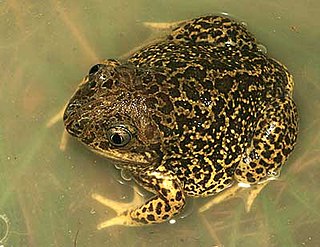
The Pelobatoidea are a superfamily of frogs. They typically combine a toad-like body shape with a frog-like, pointed face. Phylogenetically they stand between primitive frogs on the one side and higher frogs on the other and are therefore – among other things by characteristics of bone construction – in the suborder Mesobatrachia.

Pelodytes atlanticus, the Lusitanian parsley frog, is a species of frog in the family Pelodytidae, known as "parsley frogs" because of their green speckles. This species is only found in Portugal.


